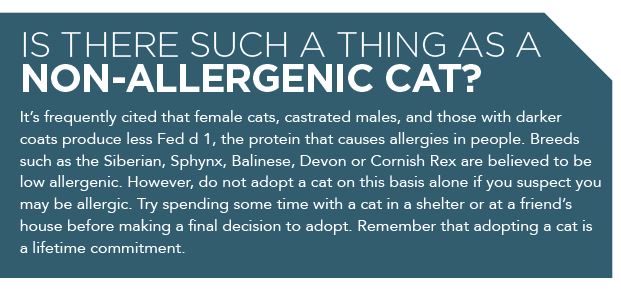Are you allergic to your cat?

If you’re allergic to your cat, does that mean you have to get rid of him? By no means. Making some changes to your lifestyle, and your cat’s, can help fix the problem.
Sneezing, a runny nose, and watery itchy eyes. Your doctor says you’re allergic to your cat. But don’t panic – this doesn’t mean you have to find another home for your beloved feline friend. Read on for some lifestyle changes you can make, for yourself and your cat, to help you feel better. It takes commitment, but with patience and persistence, it can be done.
 Start with your environment
Start with your environment
- Use air purifiers such as Purrified Air, which can be mounted on or over your cat’s litter box, or in any other space in the house, including the bedroom – this product runs silently, so it won’t disturb your sleep. It contains a replaceable 2.2 lb activated carbon filter media cartridge, and the filters last at least four months. Along with getting rid of mold spores, dust, litter box odors, and other indoor air contaminants, this air purifier also eliminates animal hair and dander, which are the chief causes of cat allergies in people.
- Designate cat-free zones in your home, particularly your bedroom. If possible, replace carpeting with hard surfaces, and use machine-washable throws on the furniture.
- Vacuum floors and upholstered furnishings regularly to suck up as much cat hair and dander as possible. Get a made-for-pets vacuum with a HEPA filter, and a steam cleaner for any carpeting.
Make changes to your cat-care regime
- Feeding your cat a high quality diet can help reduce your allergies because it will keep his coat and skin healthy, thereby minimizing dander and shedding.
- Brush your kitty regularly (or have someone else in the household do it) to get rid of old protein-laden fur. Better yet, acclimatize her to the occasional bath.
- Switching to a low-dust litter may help both the allergy sufferer and the cat. There are lots of dust-free litter choices on today’s market – experiment with a few to see how your cat likes them, and how your respiratory system responds. It may take time, but you should eventually find something that works for both you and your cat.
 Get holistic help for yourself
Get holistic help for yourself
- Physicians are quick to prescribe medications that may have side effects. Either that, or they’ll just tell patients to give up their cats. Some may suggest a course of immunotherapy injections. A more natural approach would be to consult with a holistic doctor or naturopath, who can recommend homeopathic remedies such as Allium cepa, Euphrasia, Natrum muriaticum and Nux vomica, or herbal remedies like quercetin, borage, elder or ginseng.
- Use common sense when petting your cat. Do not touch your face and eyes, and wash your hands thoroughly after petting.
- Make sure your own lifestyle is healthy. Are you eating well, getting enough exercise and sleep, and taking steps to reduce stress? If you smoke, quit if you can. The healthier you are, the stronger your immune system will become, and the less troublesome your allergies will be.
If you’re allergic to your cat, using a multi-pronged holistic approach works wonders. Don’t expect results overnight, but if you keep at it over a period of time, you should start to see your allergies lessen in severity, and perhaps even disappear.




